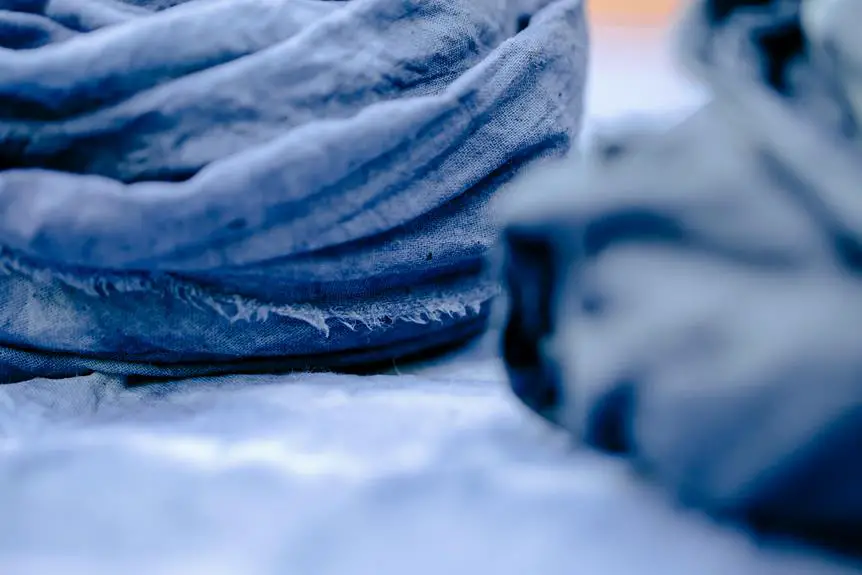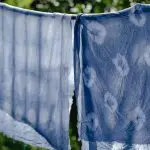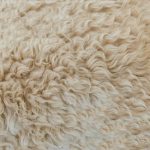When you're ready to transform your voile fabric, the process begins with proper preparation. You'll want to wash the fabric to eliminate any finishes, then soak it in a vinegar solution to ensure the dye adheres effectively. Choosing the right dye is crucial, whether you prefer natural or synthetic options, and the technique you select can significantly impact the final result. But before you make those choices, there are some key details about the dyeing process that can make all the difference in achieving the look you want.
Table of Contents
Choosing the Right Dye
When choosing the right dye for voile fabric, consider whether you want a natural or synthetic option based on your project's needs.
Natural dyes, derived from plants and minerals, offer beautiful, muted colors and are eco-friendly. However, they may require more effort and time to achieve the desired shade.
If you're looking for something vibrant and consistent, synthetic dyes are often your best bet. They provide a wider color range and tend to work more efficiently on synthetic fibers, which are commonly blended in voile fabrics.
Next, think about the dyeing method you'll use. Fabric dyes, like fiber reactive or acid dyes, can yield different results, so choose one that matches your experience level and desired outcome.
If you're unsure, start with a small test swatch to see how the dye interacts with the fabric.
Lastly, consider the intended use of your dyed voile. If it's for clothing, ensure the dye is lightfast and washable.
For home decor, you might prioritize color vibrancy over washability. By weighing these factors, you can make an informed decision that best suits your project.
Preparing Your Voile Fabric
Before you start dyeing, it's important to properly prepare your voile fabric to ensure the best results. Start by washing the fabric to remove any dirt, oils, or finishes that may interfere with dye absorption. Use a gentle detergent and rinse thoroughly. After washing, you'll want to soak the fabric in a fixative solution, such as a mixture of water and vinegar, for about 30 minutes. This step helps the dye adhere better.
Here's a quick reference table for preparing your voile fabric:
| Step | Description |
|---|---|
| 1. Wash | Use gentle detergent and rinse well. |
| 2. Soak | Immerse in vinegar solution for 30 mins. |
| 3. Dry | Air dry or tumble dry on low. |
| 4. Iron | Press the fabric to remove wrinkles. |
| 5. Gather Supplies | Collect dyes, gloves, and containers. |
Once you've completed these steps, your voile fabric will be ready for dyeing. Taking the time to prepare properly will lead to vibrant, lasting colors in your finished project.
Dyeing Techniques to Use
There are several effective dyeing techniques you can use to achieve stunning results on your voile fabric.
One popular method is immersion dyeing, where you submerge the fabric in a dye bath. This technique allows for even color distribution and works well for larger pieces. Just remember to stir occasionally for consistent results.
Another technique is tie-dyeing, which creates unique patterns. You can bunch, twist, or fold the fabric before securing it with rubber bands or string. When you dip it into the dye, the tied areas will resist color, giving you a beautiful design.
For a more intricate look, consider using a sponge or brush to apply dye directly onto the fabric. This method is great for creating gradients or specific patterns. You can also experiment with stencils for added detail.
Lastly, batik is a traditional technique that involves applying wax to the fabric to resist dye. This method takes more time and skill but results in stunning, complex designs.
Choose the technique that suits your style and the effect you want to achieve, and you'll be well on your way to beautifully dyed voile fabric!
Rinsing and Setting the Color
Rinsing the dyed voile fabric properly is crucial for setting the color and preventing it from bleeding in future washes. After you've achieved the desired color, it's time to rinse the fabric to remove any excess dye.
Start by filling a basin or sink with cold water. Gently submerge the fabric, letting it soak for a few minutes. This helps to loosen any remaining dye particles.
Next, carefully agitate the fabric in the water. You want to avoid wringing or twisting it, as this can cause damage. As you rinse, you'll notice the water may initially appear colored. Keep rinsing until the water runs clear, which indicates that most of the excess dye has been removed.
Once rinsed, it's important to set the color. You can do this by adding a cup of white vinegar to the rinse water for an extra boost. Vinegar helps to lock in the dye, ensuring long-lasting color.
After rinsing, lay the fabric flat or hang it up to air dry. Avoid direct sunlight, as it can fade the colors. This step ensures your beautifully dyed voile fabric maintains its vibrancy for many uses to come.
Caring for Dyed Voile Fabric
After setting the color, proper care of your dyed voile fabric will help maintain its vibrancy and extend its lifespan.
First, always wash your voile in cold water using a gentle detergent. Hot water can cause colors to fade, so stick to cold. When it's time to dry, air drying is your best bet. Hang your fabric in a shaded area to prevent direct sunlight from causing any fading.
If you need to iron your voile, do so on a low heat setting, preferably while it's slightly damp. This helps avoid scorching and keeps the fabric looking fresh. Avoid using any bleach or harsh chemicals, as they can damage the dye and the fabric itself.
When storing your dyed voile, keep it in a cool, dry place, away from direct sunlight. Consider using acid-free tissue paper to help maintain its shape and prevent creasing.
Lastly, if you notice any stains, treat them promptly using a mild stain remover. Quick action can prevent permanent marks and keep your dyed voile looking vibrant for years to come.
Follow these steps, and you'll enjoy your beautifully dyed fabric for a long time!
Frequently Asked Questions
Can I Dye Voile Fabric at Home Without Professional Equipment?
Yes, you can dye voile fabric at home without professional equipment. Just gather some dye, a bucket, and water. Follow the dye instructions carefully, and you'll achieve beautiful results with a little patience and creativity.
What Is the Best Time to Dye Voile Fabric?
The best time to dye fabric is during mild weather, ideally in spring or fall. You'll avoid extreme temperatures, ensuring even dye absorption. Plus, it's more enjoyable to work outside when conditions are pleasant.
How Does the Dyeing Process Affect the Fabric's Texture?
Dyeing fabric can change its texture, often making it feel stiffer or more rigid. You might notice a difference in softness or drape, depending on the dye and method you choose for your project.
Can I Mix Different Dye Colors for a Unique Effect?
Yes, you can mix different dye colors for a unique effect! Experimenting with combinations lets you create stunning shades. Just remember to test small samples first to see how they blend before dyeing larger pieces.
Is It Safe to Dye Voile Fabric Indoors?
Dyeing indoors can be safe if you take precautions. Ensure proper ventilation, use protective gear, and cover surfaces. Avoid spills, and choose non-toxic dyes to minimize health risks while enjoying your creative project.
- How Does Ring Spun Cotton Affect Garment Fit and Shape Retention? - August 13, 2024
- What Are the Challenges in Producing Ring Spun Cotton? - August 13, 2024
- Is Ring Spun Cotton Suitable for Plus-Size Clothing? - August 13, 2024







